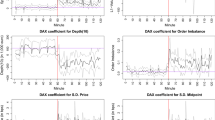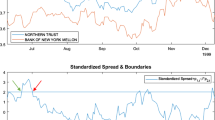Abstract
This paper investigates a linear strategy equilibrium in insider trading in continuous time allowing market makers to know some information on the value of a stock. By the use of filtering theory, the authors prove that in a monopoly market, there exists a unique equilibrium of linear strategy of intensity in a closed form, such that the insider can make positive profits and at which, all of the private information on the value of the stock is released; and the more accurate the information on the value of the stock observed by the market makers, the less the positive profits are made by the insider, and even go to zero. However, there is no Nash equilibrium in a Cournot competition market between two insiders if they both adopt a linear strategy of intensity.
Similar content being viewed by others
References
Kyle A S, Continuous auctions and insider trading, Econometrica, 1985, 53: 53–1315.
Back K, Insider trading in continuous time, Rev. Financ. Stud., 1992, 5: 5–387.
Back K and Pedersen H, Long-lived information and intraday patterns, Journal of Financial Markets, 1998, 1: 1–385.
Cho K H, Continuous auctions and insider trading: Uniqueness and risk aversion, Finance and Stochastics, 2003, 7: 7–47.
Admati A, A theory of intraday patterns: Volume and price variability, Review of Financial Studies, 1988, 1: 1–3.
Gong F and Zhou D, Insider trading in the market with rational expected price, arXiv: 1012.2160v1[q-fin.TR], 2010.
Holden C W and Subrahmanyam A, Long-lived private information and imperfect competition, J. Finance, 1992, 47: 47–247.
Fostor F D and Viswanathan S, Stratigic trading when agents forecast the forcasts of others, J. Fanance, 1996, 51: 51–1437.
Back K, Cao H H, and Willard G A, Imperfect competetion among informed traders, J. Fanance, 2000, 5: 5–2117.
Gong F and Liu H, The mixed equilibrium of insider trading in the market with rational expected price, Stochastic Analysis and Applications to Finance, Edited by Zhang T and Zhou X, World Scientific, Singapore, 2012.
Kyle A S and Wang F A, Speculation duopoly with agreement to disagree: Can overconfidence survive the market test?, J. Finance, 1997, 2: 2–2073.
Jain N and Mirman L J, Insider trading with correlated signals, Economics Letters, 1999, 65: 65–105.
Jain N and Mirman L J, Real and financial effects of insider trading with correlated signals, Economic Theory, 2000, 16: 16–333.
Aase K K, Bjuland T, and Øksendal B, Strategic insider trading equilibrium: A filter theory approach, Afr. Mat., 2012, 23: 23–145.
Basar T and Olsder G J, Dynamic Noncooperative Game Theory, Academic Press Inc. Ltd., London, 1982.
Haurie A, Krawczyk J B, and Zaccour G, Games and Dynamic Games (I), World Scientific, Singapore, 2012.
Øksendal B, Stochastic Differential Equations, 6th Edition, Springer, Berlin Heidelberg, 2003.
Liptser R S and Shiryaev A N, Statistic of Random Process: II Applications, Springer, Berlin Heidelberg, 2001.
Author information
Authors and Affiliations
Corresponding author
Additional information
This research was supported by the National Natural Science Foundation of China under Grant No. 11161011 and China Scholarship Council under Grant No. 201308525118.
This paper was recommended for publication by Editor ZHANG Xun.
Rights and permissions
About this article
Cite this article
Zhou, Y. Existence of linear strategy equilibrium in insider trading with partial observations. J Syst Sci Complex 29, 1281–1292 (2016). https://doi.org/10.1007/s11424-015-4186-x
Received:
Revised:
Published:
Issue Date:
DOI: https://doi.org/10.1007/s11424-015-4186-x




